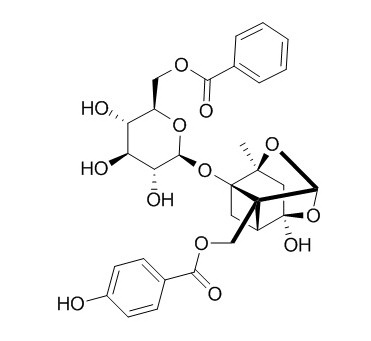Benzoyloxypeoniflorin
Benzoyloxypeoniflorin contributes to improving blood circulation through their inhibitory effects on both platelet aggregation and blood coagulation.
Inquire / Order:
manager@chemfaces.com
Technical Inquiries:
service@chemfaces.com
Tel:
+86-27-84237783
Fax:
+86-27-84254680
Address:
1 Building, No. 83, CheCheng Rd., Wuhan Economic and Technological Development Zone, Wuhan, Hubei 430056, PRC
Providing storage is as stated on the product vial and the vial is kept tightly sealed, the product can be stored for up to
24 months(2-8C).
Wherever possible, you should prepare and use solutions on the same day. However, if you need to make up stock solutions in advance, we recommend that you store the solution as aliquots in tightly sealed vials at -20C. Generally, these will be useable for up to two weeks. Before use, and prior to opening the vial we recommend that you allow your product to equilibrate to room temperature for at least 1 hour.
Need more advice on solubility, usage and handling? Please email to: service@chemfaces.com
The packaging of the product may have turned upside down during transportation, resulting in the natural compounds adhering to the neck or cap of the vial. take the vial out of its packaging and gently shake to let the compounds fall to the bottom of the vial. for liquid products, centrifuge at 200-500 RPM to gather the liquid at the bottom of the vial. try to avoid loss or contamination during handling.
Journal of Ginseng Research2021, 15 June.
Environ Toxicol.2019, 34(4):513-520.
Mol Nutr Food Res.2024, 68(20):e2400414.
ACS Omega.2023, 9(1):1278-1286.
Nutrients2022, 14(3),695.
In Vivo.2022, 36(3):1136-1143.
bioRxiv2021, 462065.
Molecules.2022, 27(13):4227.
Sci Rep.2018, 8(1)
Journal of Pharmaceutical Investigation2024, 024-00662-1.
Related and Featured Products
Pharmazie. 2010 Aug;65(8):624-8.
Platelet anti-aggregatory and blood anti-coagulant effects of compounds isolated from Paeonia lactiflora and Paeonia suffruticosa.[Pubmed:
20824965]
The roots of two Paeoniaceae family members have long been used as traditional medicines in Korea, China, and Japan. Dry roots of Paeonia lactiflora and dry root bark of P. suffruticosa are used under the traditional names of Paeoniae Radix and Moutan Cortex, respectively.
METHODS AND RESULTS:
Both Paeoniae Radix and Moutan Cortex have been used as remedies for cardiovascular diseases, for improving blood circulation, or for other uses. It was postulated that both plants may contain common active constituents that contribute to inhibiting blood coagulation and/or platelet aggregation. Eighteen compounds, which have been reported to be present in both plant medicines, were evaluated for their effects on platelet aggregation and blood coagulation. Paeonol (5), paeoniflorin (9), benzoylpaeoniflorin (11), and Benzoyloxypeoniflorin (12) were found to be the major common active constituents and they would collectively contribute to improving blood circulation through their inhibitory effects on both platelet aggregation and blood coagulation. In addition, methylgallate (4), (+)-catechin (7), paeoniflorigenone (8), galloylpaeoniflorin (13), and daucosterol (16) may also take part in improving blood circulation by inhibiting ether platelet aggregation and/or blood coagulation.
Evid Based Complement Alternat Med . 2019 Mar 3;2019:6150357.
The Screening Research of NF- κ B Inhibitors from Moutan Cortex Based on Bioactivity-Integrated UPLC-Q/TOF-MS[Pubmed:
30941197]
Abstract
Inflammation is a common and important pathological process, and nuclear factor-κB (NF-κB) is a key mediator of it. Moutan Cortex (MC), the dried root cortex of Paeonia suffruticosa Andr., is widely used as a remedy for the treatment of inflammatory diseases in Asian region. However, there are few studies on the systematic identification of NF-κB inhibitors of MC. In this study, the effect of inhibiting NF-κB activation of MC was assessed at the cellular level using a tumor necrosis factor-α (TNF-α) induced inflammatory model. Subsequently, ultra-performance liquid chromatography-quadrupole/time of flight-mass spectrometry (UPLC-Q/TOF-MS) combined with biological activity assay was established to screen and identify potential anti-inflammatory ingredients in MC. The results revealed that MC significantly inhibited the activation of NF-κB. Seven potential NF-κB inhibitors were screened from MC, including oxypaeoniflorin, paeoniflorin, galloylpaeoniflorin, benzoyloxypaeoniflorin, mudanpioside C, gallic acid, and paeonol. Among them, the NF-κB inhibitor activity of galloylpaeoniflorin, benzoyloxypaeoniflorin, and mudanpioside C is first reported here. In conclusion, the anti-inflammatory activity of MC was associated with the seven components mentioned above. And the bioactivity-integrated UPLC-Q/TOF which contains both chemical and bioactive details is suitable for screening active ingredients from natural medicines.



